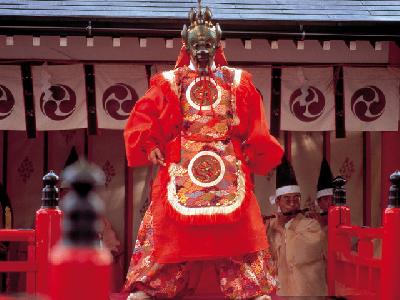|
Hayashi-ke Bugaku (Hayashi Family Court Dancing) is a type of 'kagura' (Shinto music and dance) taught and handed down from generation to generation in the valleys of Nishimurayama County in Yamagata Prefecture. Along with Miyanaka, Osaka Shitennouji, and Naranangungakusho, it is one of the four major kagura, and is designated as an Intangible Cultural Treasure by the country.
First introduced to Japan along with Buddhism via the Silk Road, this dance form took more than two centuries, from the 6th to the 8th, to root itself. Having adopted instruments, flamboyant (usually red) costumes, as well as vibrant masks and vigorous dance steps, kagura was mainly used in Buddhist rites. Hayashi-ke Bugaku is said to be of a 'Tennouji type'.
The master Shoutoku Daishi taught kagura from Nanba Tennouji Temple, and granted surnames to a limited number of kagura performers. 'Hayashi' was one of the surnames. One branch of the Hayashi family moved to the mountains of Yamagata and were chosen to perform rites at Zennon Temple and Tateishi Temple. Far removed from the capital, the style of kagura they performed remained truer to its origins. Even today, after more than 1100 years, Hayashi-ke Bugaku reflects influences from its route to Japan along the Silk Road.
First introduced to Japan along with Buddhism via the Silk Road, this dance form took more than two centuries, from the 6th to the 8th, to root itself. Having adopted instruments, flamboyant (usually red) costumes, as well as vibrant masks and vigorous dance steps, kagura was mainly used in Buddhist rites. Hayashi-ke Bugaku is said to be of a 'Tennouji type'.
The master Shoutoku Daishi taught kagura from Nanba Tennouji Temple, and granted surnames to a limited number of kagura performers. 'Hayashi' was one of the surnames. One branch of the Hayashi family moved to the mountains of Yamagata and were chosen to perform rites at Zennon Temple and Tateishi Temple. Far removed from the capital, the style of kagura they performed remained truer to its origins. Even today, after more than 1100 years, Hayashi-ke Bugaku reflects influences from its route to Japan along the Silk Road.
| [+ADDRESS] | 
|











